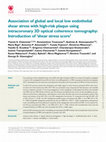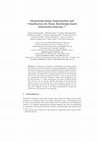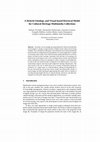Papers by Ioannis (Yiannis) Kompatsiaris

European heart journal cardiovascular Imaging, Jan 26, 2016
The association of low endothelial shear stress (ESS) with high-risk plaque (HRP) has not been th... more The association of low endothelial shear stress (ESS) with high-risk plaque (HRP) has not been thoroughly investigated in humans. We investigated the local ESS and lumen remodelling patterns in HRPs using optical coherence tomography (OCT), developed the shear stress score, and explored its association with the prevalence of HRPs and clinical outcomes. A total of 35 coronary arteries from 30 patients with stable angina or acute coronary syndrome (ACS) were reconstructed with three dimensional (3D) OCT. ESS was calculated using computational fluid dynamics and classified into low, moderate, and high in 3-mm-long subsegments. In each subsegment, (i) fibroatheromas (FAs) were classified into HRPs and non-HRPs based on fibrous cap (FC) thickness and lipid pool size, and (ii) lumen remodelling was classified into constrictive, compensatory, and expansive. In each artery the shear stress score was calculated as metric of the extent and severity of low ESS. FAs in low ESS subsegments had t...
2015 IEEE International Conference on Multimedia & Expo Workshops (ICMEW), 2015

An approach for knowledge assisted semantic analysis and annotation of video content, based on an... more An approach for knowledge assisted semantic analysis and annotation of video content, based on an ontology infrastructure is presented. Semantic concepts in the context of the examined domain are defined in an ontology, enriched with qualitative attributes of the semantic objects (e.g. color homogeneity), multimedia processing methods (color clustering, respectively), and numerical data or low-level features generated via training (e.g. color models, also defined in the ontology). Semantic Web technologies are used for knowledge representation in RDF/RDFS language. Rules in F-logic are defined to describe how tools for multimedia analysis should be applied according to different object attributes and low-level features, aiming at the detection of video objects corresponding to the semantic concepts defined in the ontology. This supports flexible and managed execution of various application and domain independent multimedia analysis tasks. This ontology-based approach provides the means of generating semantic metadata and as a consequence Semantic Web services and applications have a greater chance of discovering and exploiting the information and knowledge in multimedia data. The proposed approach is demonstrated in the Formula One and Football domains and shows promising results.

In this paper we present the Qimera segmentation platform and describe the different approaches t... more In this paper we present the Qimera segmentation platform and describe the different approaches to segmentation that have been implemented in the system to date. Analysis techniques have been implemented for both region-based and object-based segmentation. The region-based segmentation algorithms include: a colour segmentation algorithm based on a modified Recursive Shortest Spanning Tree (RSST) approach, an implementation of a colour image segmentation algorithm based on the K -Means-with-Connectivity-Constraint (KMCC) algorithm and an approach based on the Expectation Maximization (EM) algorithm applied in a 6D colour/texture space. A semi-automatic approach to object segmentation that uses the modified RSST approach is outlined. An automatic object segmentation approach via snake propagation within a level-set framework is also described. Illustrative segmentation results are presented in all cases. Plans for future research within the Qimera project are also discussed.
The paper studies the problem of community detection in tag networks, i.e. networks consisting of... more The paper studies the problem of community detection in tag networks, i.e. networks consisting of associations between tags that are used within Social Tagging Systems (STS) to annotate online resources (e.g. bookmarks, pictures, videos, etc.). Community detection methods aim at uncovering densely connected groups of tags, which can reveal the topic structure emerging in the STS. In this way, community detection in tag networks leverages Collective Intelligence (CI), that is the intelligence that is accumulated as a result of the collective activities of masses of users.
The increasing importance of Web 2.0 applications during the last years has created significant i... more The increasing importance of Web 2.0 applications during the last years has created significant interest in tools for analyzing and describing collective user activities and emerging phenomena within the Web. Network structures have been widely employed in this context for modeling users, web resources and relations between them. However, the amount of data produced by modern web systems results in networks that are of unprecedented size and complexity, and are thus hard to interpret. To this end, community detection methods attempt to uncover natural groupings of web objects by analyzing the topology of their containing network.
Proceedings of the 21st ACM international conference on Multimedia - MM '13, 2013
ABSTRACT In this paper, a new method that exploits related videos for the problem of event detect... more ABSTRACT In this paper, a new method that exploits related videos for the problem of event detection is proposed, where related videos are videos that are closely but not fully associated with the event of interest. In particular, the Weighted Margin SVM formulation is modified so that related class observations can be effectively incorporated in the optimization problem. The resulting Relevance Degree SVM is especially useful in problems where only a limited number of training observations is provided, e.g., for the EK10Ex subtask of TRECVID MED, where only ten positive and ten related samples are provided for the training of a complex event detector. Experimental results on the TRECVID MED 2011 dataset verify the effectiveness of the proposed method.

The PESCaDO system (Personal Environmental Service Configuration and Delivery Orchestration) aims... more The PESCaDO system (Personal Environmental Service Configuration and Delivery Orchestration) aims at providing accurate and timely information about local air quality and weather conditions in Europe. The system receives environment related queries from end users, discovers reliable environmental multimedia data in the web from different providers and processes these data in order to convert them into information and knowledge. Finally, the system uses the produced information to provide the end user a personalized response. In this paper, we present the general architecture of the above mentioned system, focusing on the extraction and fusion of multimedia environmental data. The main research contribution of the proposed system is a novel information fusion method based on statistical regression modelling that uses as input data land use and population density masks, historic track-record of data providers as well as an array of atmospheric measurements at various locations. An implementation of this fusion model has been successfully tested against two selected datasets on air pollutant concentrations and ambient air temperatures.

Atherosclerosis, 2015
Geometrically-correct 3D OCT is a new imaging modality with the potential to investigate the asso... more Geometrically-correct 3D OCT is a new imaging modality with the potential to investigate the association of local hemodynamic microenvironment with OCT-derived high-risk features. We aimed to describe the methodology of 3D OCT and investigate the accuracy, inter- and intra-observer agreement of 3D OCT in reconstructing coronary arteries and calculating ESS, using 3D IVUS and 3D QCA as references. 35 coronary artery segments derived from 30 patients were reconstructed in 3D space using 3D OCT. 3D OCT was validated against 3D IVUS and 3D QCA. The agreement in artery reconstruction among 3D OCT, 3D IVUS and 3D QCA was assessed in 3-mm-long subsegments using lumen morphometry and ESS parameters. The inter- and intra-observer agreement of 3D OCT, 3D IVUS and 3D QCA were assessed in a representative sample of 61 subsegments (n = 5 arteries). The data processing times for each reconstruction methodology were also calculated. There was a very high agreement between 3D OCT vs. 3D IVUS and 3D OCT vs. 3D QCA in terms of total reconstructed artery length and volume, as well as in terms of segmental morphometric and ESS metrics with mean differences close to zero and narrow limits of agreement (Bland-Altman analysis). 3D OCT exhibited excellent inter- and intra-observer agreement. The analysis time with 3D OCT was significantly lower compared to 3D IVUS. Geometrically-correct 3D OCT is a feasible, accurate and reproducible 3D reconstruction technique that can perform reliable ESS calculations in coronary arteries.

Multimedia Modeling, 2009
In this paper we propose a methodology for semantic indexing of images, based on techniques of im... more In this paper we propose a methodology for semantic indexing of images, based on techniques of image segmentation, classification and fuzzy reasoning. The proposed knowledge-assisted analysis architecture integrates algorithms applied on three overlapping levels of semantic information: i) no semantics, i.e. segmentation based on low-level features such as color and shape, ii) mid-level semantics, such as concurrent image segmentation and object detection, region-based classification and, iii) rich semantics, i.e. fuzzy reasoning for extraction of implicit knowledge. In that way, we extract semantic description of raw multimedia content and use it for indexing and retrieval purposes, backed up by a fuzzy knowledge repository. We conducted several experiments to evaluate each technique, as well as the whole methodology in overall and, results show the potential of our approach.

International Journal of Metadata, Semantics and Ontologies, 2008
Nowadays, an increasingly growing demand for advanced multimedia search engines is arising, as hu... more Nowadays, an increasingly growing demand for advanced multimedia search engines is arising, as huge amounts of digital visual content are becoming available. The contribution of this paper is the introduction of a hybrid multimedia retrieval model accompanied by the presentation of a search engine that is capable of retrieving visual content from cultural heritage multimedia libraries as in three modes: (i) based on their semantic annotation with the help of an ontology; (ii) based on the visual features with a view to finding similar content; and (iii) based on the combination of these two strategies in order to produce recommendations. To achieve this, the retrieval model is composed of two different parts, a low-level visual feature analysis and retrieval and a high-level ontology infrastructure. The main novelty is the way in which these two co-operate transparently during the evaluation of a single query in a hybrid fashion, making recommendations to the user and retrieving content that is both visually and semantically similar. A search engine has been developed implementing this model which is capable of searching through digital libraries of cultural heritage collections, and indicative examples are discussed, along with insights into its performance.
Computers in Biology and Medicine, 2007
The detection of lumen and media-adventitia borders in intravascular ultrasound (IVUS) images con... more The detection of lumen and media-adventitia borders in intravascular ultrasound (IVUS) images constitutes a necessary step for the quantitative assessment of atherosclerotic lesions. To date, most of the segmentation methods reported are either manual, or semi-automated, requiring user interaction at some extent, which increases the analysis time and detection errors. In this work, a fully automated approach for lumen and media-adventitia border detection is presented based on an active contour model, the initialization of which is performed via an analysis mechanism that takes advantage of the inherent morphologic characteristics of IVUS images. The in vivo validation of the proposed model in human coronary arteries revealed that it is a feasible approach, enabling accurate and rapid segmentation of multiple IVUS images. ᭧

International Journal of Cardiology, 2014
The analysis of intracoronary optical coherence tomography (OCT) images is based on manual identi... more The analysis of intracoronary optical coherence tomography (OCT) images is based on manual identification of the lumen contours and relevant structures. However, manual image segmentation is a cumbersome and time-consuming process, subject to significant intra- and inter-observer variability. This study aims to present and validate a fully-automated method for segmentation of intracoronary OCT images. We studied 20 coronary arteries (mean length=39.7±10.0 mm) from 20 patients who underwent a clinically-indicated cardiac catheterization. The OCT images (n=1812) were segmented manually, as well as with a fully-automated approach. A semi-automated variation of the fully-automated algorithm was also applied. Using certain lumen size and lumen shape characteristics, the fully- and semi-automated segmentation algorithms were validated over manual segmentation, which was considered as the gold standard. Linear regression and Bland-Altman analysis demonstrated that both the fully-automated and semi-automated segmentation had a very high agreement with the manual segmentation, with the semi-automated approach being slightly more accurate than the fully-automated method. The fully-automated and semi-automated OCT segmentation reduced the analysis time by more than 97% and 86%, respectively, compared to manual segmentation. In the current work we validated a fully-automated OCT segmentation algorithm, as well as a semi-automated variation of it in an extensive "real-life" dataset of OCT images. The study showed that our algorithm can perform rapid and reliable segmentation of OCT images.
Abstract The article describes a new way of t-learning presentation that was developed by the EU ... more Abstract The article describes a new way of t-learning presentation that was developed by the EU 6th Framework Program project Enhanced Learning Unlimited (ELU). One of the project's main goals was to pomote the importance of t-learning using new technologies ...
14th International Conference of Image Analysis and Processing - Workshops (ICIAPW 2007), 2007
Nowadays, an increasingly growing demand for the creation of digital multimedia libraries is aris... more Nowadays, an increasingly growing demand for the creation of digital multimedia libraries is arising, as huge amounts of digital visual content are becoming available. The content that resides in these libraries should be easily retrievable and classified in order to be fully accessible.
2015 IEEE 15th International Conference on Advanced Learning Technologies, 2015
2015 International Conference on Interactive Mobile Communication Technologies and Learning (IMCL), 2015
Communications in Computer and Information Science, 2016







Uploads
Papers by Ioannis (Yiannis) Kompatsiaris